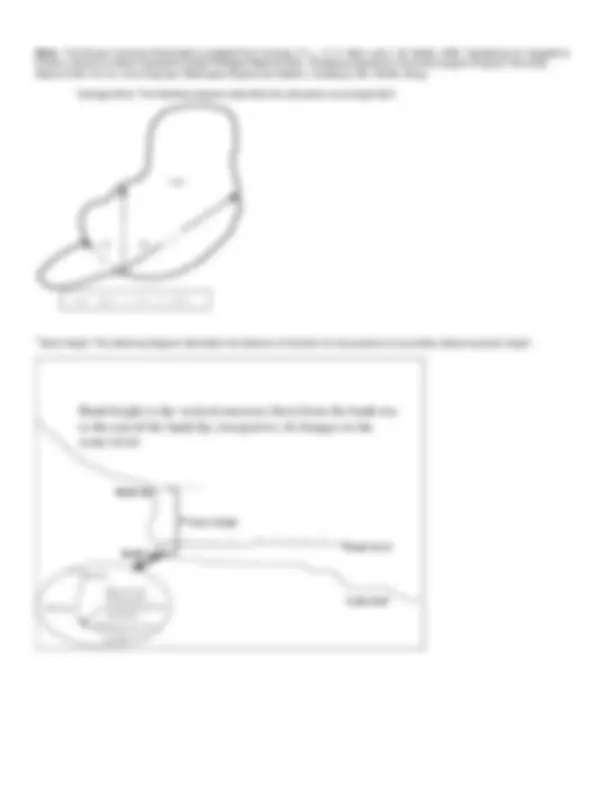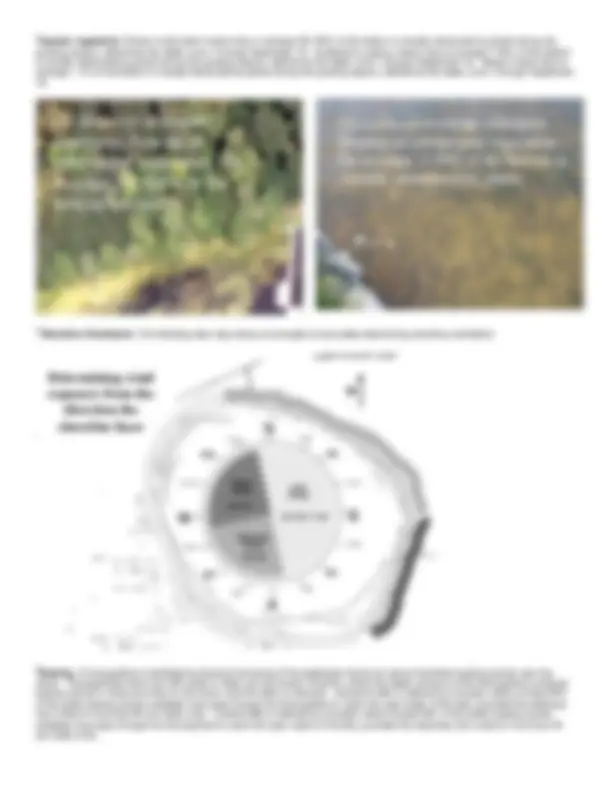




Study with the several resources on Docsity

Earn points by helping other students or get them with a premium plan


Prepare for your exams
Study with the several resources on Docsity

Earn points to download
Earn points by helping other students or get them with a premium plan
Community
Ask the community for help and clear up your study doubts
Discover the best universities in your country according to Docsity users
Free resources
Download our free guides on studying techniques, anxiety management strategies, and thesis advice from Docsity tutors
A worksheet for calculating the Erosion Intensity (EI) Score, which is required under ch. NR 328, Wis. Adm. Code when reporting EI Scores. The worksheet includes variables such as average fetch, depth at 20 feet, depth at 100 feet, bank height, bank composition, influence of adjacent structures, aquatic vegetation, bank vegetation, bank stability, shoreline geometry, shore orientation, and boat wakes. The document also includes a certification section. The worksheet is used to determine the degree of erosion at a shore protection site.
Typology: Slides
1 / 4

This page cannot be seen from the preview
Don't miss anything!



State of Wisconsin Department of Natural Resources PO Box 7921, Madison WI 53707- dnr.wi.gov Notice: , This data form is required under ch. NR 328, Wis. Adm. Code when reporting Erosion Intensity (EI) Scores. Personally identifiable information included on this form will be used to contact you and is not intended to be used for other purposes. It may be made available to requesters under Wisconsin's Open Records law [ ss. 19.31-19.39, Wis. Stats.].
Section IV: Certification
I hereby certify that the information contained herein is true and accurate. I am the owner of the riparian property or am the duly authorized representative and may sign this data submission on behalf of the owner(s) of said property. I have read and understand all data conditions listed in this form. I have conducted the monitoring project to comply with these conditions. I understand that incorrect information may result in a Departmental determination that the data submission herein is null and void under the provisions of ch. 30, Wis. Stats.
Applicants and department staff shall use this worksheet to calculate erosion intensity pursuant to s. NR 328.08(2). Where an applicant or the department believes that, as a result of site conditions, storm-wave height as calculated in sub. (1) may inaccurately predict the degree of erosion, the erosion intensity score may be calculated to determine erosion. When the department or applicants assess erosion intensity (EI) at the shore protection site they shall apply methods outlined in this worksheet. Wherever EI and storm-wave height result in different energy categories, the site shall be placed in the category as determined by EI.
SHORELINE
VARIABLES
DESCRIPTIVE CATEGORIES
AVERAGE FETCH^1 - , average distance (miles), across the open water to the opposite shore measure 45^0 other side of the perpendicular to the shoreline.
DEPTH AT 20 FEET, (^) Depth of water (feet) 20 feet from shoreline
DEPTH AT 100 FEET, (^) depth of water (feet) 100 feet from shoreline
BANK HEIGHT^2 , (^) height of bank (feet), measure from toe of the bank to top of the bank-lip.
composition and degree of cementation of the sediments
(0) rock, marl, tight clay, well cemented sand (dig with a pick)
(7) soft clay, clayey sand, moderately cemented (easily dug with a knife)
(15) uncemented sands or peat (easily dug with your hand) INFLUENCE OF ADJACENT STRUCTURES, (^) likelihood that adjacent structures are causing flank erosion at the site
(0) no hard armoring on either adjacent property
(1) hard armoring on one adjacent property
(2) hard armoring on both adjacent properties
(3) hard armoring on one adjacent property with measurable recession
(4) hard armoring on both adjacent properties with measurable recession adjacent to both structures AQUATIC VEGETATION^3 type and abundance of vegetation occurring in the water off the shoreline
(0) rocky substrates unable to support vegetation.
(1) dense or abundant emergent, floating or submerged vegetation
(4) scattered or patchy emergent, floating or submergent vegetation
(7) lack of emergent, floating or submergent vegetation BANK VEGETATION, (^) type and abundance of the vegetation occurring on the bank face and immediately on top of the bank lip
(0) bank compose of rocky outcropping unable to support vegetation
(1) dense vegetation, upland trees, shrubs and grasses, including lawns
(4) clumps of vegetation alternating with areas lacking vegetation
(7) lack of vegetation (cleared), crop or agricultural land
BANK STABILITY, (^) The degree to which bank and adjacent area (within 10 feet of the bank-lip) is stabilized by natural ground, shrub, and canopy vegetation (outside a 10’ pier access corridor). Human disturbance is typified by tree removal, brushing, mowing, and lawn establishment.
established lawn with few canopy trees
(1) established lawn with moderate to dense canopy trees
(4) moderate to dense natural ground vegetation and canopy trees with shrub layer substantially reduced; or few canopy trees with moderate to dense natural shrub layer.
(7) moderate to dense canopy trees with moderate to dense natural shrub layer; or other natural features prevents establishment of vegetation. SHORELINE GEOMETRY general shape of the shoreline at the point of interest plus 200 yards on either side.
(1) coves or bays (4) irregular shoreline or straight shoreline
(8) headland, point, or island
SHORE ORIENTATION^4 geographic direction the shoreline faces
(0) < 1/3 mile fetch
(1) north to east to south- southeast (349^0 -360^0 , 1^0 - 1680 )
(4) south to west- southwest (169^0 - 2580 )
(8) west to north- northwest (259^0 - 3490 ) BOAT WAKES^5 proximity to and use of boat channels
(1) no channels within 100 yards, broad open water body, or constricted shallow water body; or channels within no-wake zones
(6) thoroughfare within 100 yards carrying limited traffic, or thoroughfare 100 yards to ½ mile offshore carrying intensive traffic
(12) thoroughfare within 100 yards carrying intensive traffic (unregulated boating activity)
EROSION INTENSITY SCORE (EI)
(^3) Aquatic vegetation: Dense or abundant means that on average 50-100% of the bottom is visually obstructed by plants during the growing season, defined by the dates June 1 through September 15. Scattered or patchy means that on average 1-49% of the bottom is visually obstructed by plants during the growing season, defined by the dates June 1 through September 15. Absent means that on average < 1% of the bottom is visually obstructed by plants during the growing season, defined by the dates June 1 through September
emergent, floating or submerged vegetation; On average, 50-100% of the bottom is visually
floating or submergent vegetation: On average, 1-49% of the bottom is visually obstructed by plants.
(^4) Shoreline Orientation: The following lake map shows an example of accurately determining shoreline orientation
NNE
SSE SE ESE
ENE NE WSW SW SSW WNW NW NNW
450 67.5^0 900 112.5^0 (^1350) 247.5^0 (^2250) 202.5^0 2700 (^1800) 157.7^0 3150 337.5^0 292.5^0 (^3600) 22.5^0 Light Winds Moderate Winds Heavy Winds 1690 -258^0 2590 -348 0 3490 -360^0 , 1^0 -168^0
exposure from the direction the shoreline faces
(^5) Boating : A thoroughfare is identified as physical narrowing of the waterbody that by its nature intensifies boating activity near the shore. Thoroughfares which are 250 yards or wider are not scored 12 points, unless the depth contours of the thoroughfare constricts boating activity in close proximity to one shore, and the traffic is intensive. Intensive traffic is defined by a location where at least 50% of the public boating access available must pass through the thoroughfare to reach the open water of the lake, provided the waterway has a total of more than 60 car-trailer units. Limited traffic is defined by a location where at least 30% of the public boating access available must pass through the thoroughfare to reach the open water of the lake, provided the waterway has a total of more than 40 car-trailer units.